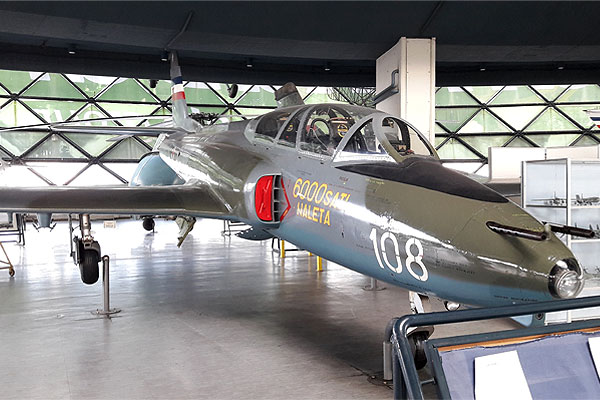The museum owns over 200 aircraft previously operated by the Yugoslav Air Force (both royal and communist), Serbian Air Force, and others, as well as aircraft previously flown by several civil airliners and private flying clubs.
The Aeronautical Museum Belgrade (formerly the Yugoslav Aeronautical Museum) was founded in 1957 in Surcin, Belgrade. The museum is located adjacent to Belgrade Nikola Tesla Airport. The current facility, designed by architect Ivan Straus, was opened to the public on May 21, 1989.
The museum owns over 200 aircraft previously operated by the Yugoslav Air Force (both royal and communist), Serbian Air Force, and others, as well as aircraft previously flown by several civil airliners and private flying clubs. It also owns the only known surviving example of the Fiat G.50. The most valuable collections are housed in geodesic glass building, with additional aircraft displayed on the surrounding grounds. The museum also displays wreckage of a downed USAF F-117 Nighthawk and F-16 Fighting Falcon, both shot down during the NATO bombing of Yugoslavia in 1999. In addition, the collection consists of more than 130 aviation engines, more radars, rockets, various aeronautical equipment, over 20,000 reference books and technical documentation as well as more than 200,000 photographs.
The museum also displays wreckage of a downed USAF F-117 Nighthawk and F-16 Fighting Falcon, both shot down during the NATO bombing of Yugoslavia in 1999. In addition, the collection consists of more than 130 aviation engines, more radars, rockets, various aeronautical equipment, over 20,000 reference books and technical documentation as well as more than 200,000 photographs.

At the very entrance to the main exhibition level, visitors come across an antique aircraft that was built in 1909 and early 1910 by aviation pioneer and Subotica native Ivan Saric. In early 1910, Saric completed his one-winged Sarić 1 aircraft by incorporating the 24-horsepower Delphos engine. On 16 October 1910, in front of 7,000 of his fellow citizens, Sarić took to air successfully. In 1911 he built Sarić 2, an improved airplane with 50-horsepower.

His further excursions into flying were stopped by the First World War but Sarić continued the work on the ground experimenting with a flying machine that could take off vertically- a sort of early helicopter with a motor of a double star shape. Until the end of his life, he continued with his inventions and constructions and remained a sports promoter.
The Nieuport biplane that Serbian pilots flew during the Thessalonica Front military operations (1916-1918) draws a good bit of attention. Experts, however, believe the Museum collection's most valuable items are an array of fighter planes and fighter-bombers, including specimens of the German Messerschmitt ME-109, the English Hurricane and Spitfire, the Russian Yakovlev Yak-3 and Ilyushin Il-2 and the American B-47 Thunderbolt. Perhaps the most interesting part of the latter section of the exhibition are parts of the US F-117 Nighthawk Stealth fighter bomber and the F-16, as well as an assortment of pilotless drones -all of which were shot down over Serbia during the 1999 NATO bombing campaign.
Perhaps the most interesting part of the latter section of the exhibition are parts of the US F-117 Nighthawk Stealth fighter bomber and the F-16, as well as an assortment of pilotless drones -all of which were shot down over Serbia during the 1999 NATO bombing campaign.
The exhibition's central section is taken up by the domestic Galeb, Jastreb and Orao jet aircraft – constructed at the Aviation and Technical Institute in Zarkovo and manufactured in the Soko and Utva factories.
Vicky is the co-founder of TravelDailyNews Media Network where she is the Editor-in Chief. She is also responsible for the daily operation and the financial policy. She holds a Bachelor's degree in Tourism Business Administration from the Technical University of Athens and a Master in Business Administration (MBA) from the University of Wales.
She has many years of both academic and industrial experience within the travel industry. She has written/edited numerous articles in various tourism magazines.








































































































































































